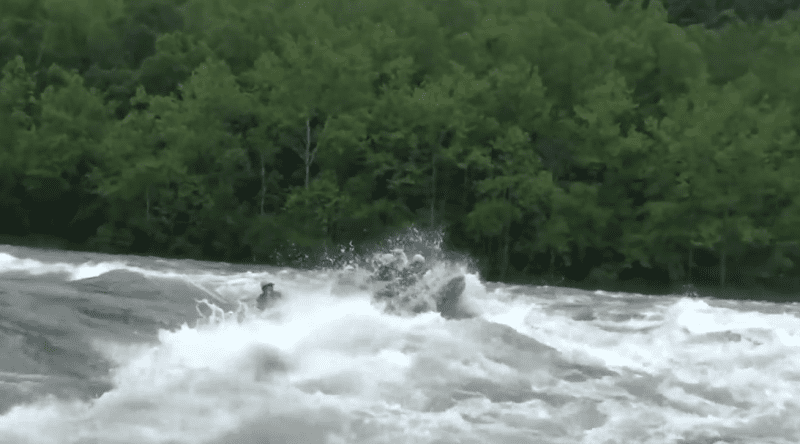April 1, 2022
Upper Railroad Rapid, Lower New River Gorge
SELECT A RAPID BELOW
INFORMATION
RAPID NAME: Upper Railroad
RAPID RATING: Class IV
RIVER SECTION: Lower New River Gorge - Cunard To Fayette Station
This Class IV rapid is named for being just upstream of the railroad trestle that crosses the New River and is your first major rapid on the Lower New.
32,000-14,000 cfs(12-7’) – At high flows, the dominating river feature at the entrance is the river right wave/hydraulic known as Maytag. From around 17,200 cfs(8’) and up, the left side of Maytag is a runnable, 6-7’ tall breaking wave. The farther right on the wave, the stronger the break, becoming more of a hydraulic far right. The main tongue/downstream V is to the left of Maytag. Downstream, as you approach the railroad trestle, there are two large wave features named Chicago and Detroit. Chicago is in the center of the river and Detroit is downstream and to the right. At high flows, this rapid is fairly wide open after passing Maytag at the entrance.

14,000-7,500 cfs(7-4’) – At these upper-mid level flows, the entrance features become more defined, with Maytag continuing to be the dominating feature. Maytag is an extremely strong recirculating hydraulic and should most definitely be avoided. The current at the entrance is deceptive and pulls hard to the right. To the left of Maytag, the tongue/downstream V is now more defined, delineating the deepest channel and smoothest line. To the left of the tongue, a wave known as The Hit begins to form. As the water level gets lower, The Hit becomes more defined, with a larger, stronger foam pile. It is surfable in a kayak and has the ability to flip rafts if not run with enough momentum. Safety eddies are far right and far left. Downstream, Chicago and Detroit are now more defined as well and are strong pour-overs/hydraulics with recirculating potential for swimmers and/or kayaks. There are runnable lines left of Chicago as well as in between the two features.

7,500-4,400 cfs(4-2’) – At these mid-level flows, the entrance features of Maytag, the tongue/downstream V, and The Hit become even more defined. Current still pulls right, but there is now a small eddy just upstream that can be used to help avoid Maytag. Maytag is still a recirculating hydraulic and The Hit is still surfable in a kayak and can flip rafts without enough momentum. At these levels, The Hit is strong enough to retain and surf rafts. Safety eddies are far right and far left. Downstream, Chicago and Detroit are steep pour-overs with recirculating potential. The area near Detroit and to the right also begins to develop severe entrapment potential with more rocks becoming exposed. Runnable lines still exist between Chicago and Detroit and to the left of Chicago.

4,400-2,400 cfs(2-0’) – At these low flows, Maytag becomes more of a ledge, with parts of the rock becoming exposed. There are options for boofs in a kayak along the Maytag ledge. The Hit slowly disappears more and more as you get closer to 2,400 cfs(0’). Large eddies exist on the right and left. Chicago and Detroit become exposed rocks with many other rocks becoming exposed on the right. The main channel of water is to the left of Chicago.
